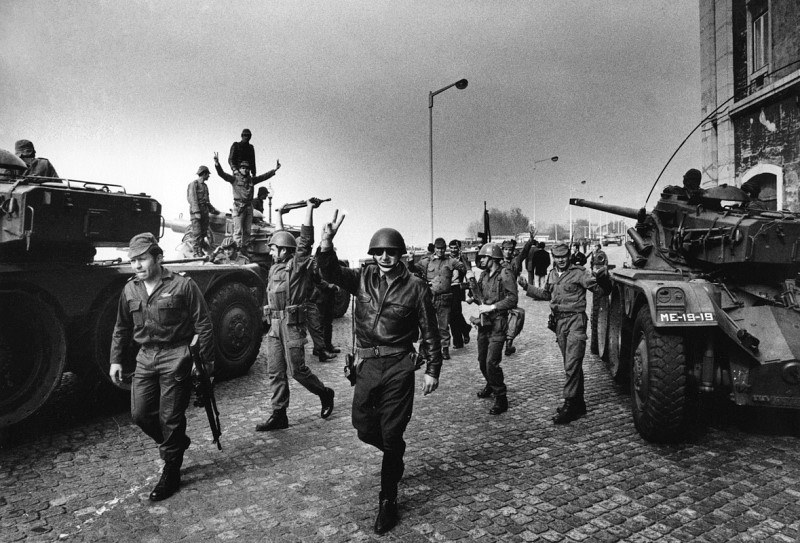45 years ago I was residing at the university residence, Mendonça Monteiro, right behind São Bento Palace in Lisbon. That day, very early, I left my apartment and I felt that “there was something in the air” …
I passed by the Palace and soon I was in Commerce Square, it was around 8:00 am. At the Square, I saw a column of tanks, some jeeps, and many military men, uniformed and equipped with automatic guns G3. I spoke to some of them trying to know the reason for that presence and their intentions.
Having returned from the war in Guinea a year earlier, where I fulfilled my commission as Ranger Ensign Officer of Especial Operations, those militaries in green uniforms seemed to me “blowtorches,” a term used to define someone new in the army with little training and very little experience in handling weapons.
A cavalry captain, with bright rank slides, and the regiment badge on his chest, was holding a G3 in his hand, and paced from one side to another. A contrasted situation from my experience when stationed in Ingoré (Guinea, the northern border with Senegal) where we did not use any symbol for identification, especially when we were leaving for operations outside the perimeter of the base.
The captain moved from one place to another and at one point he ordered the militaries to “jump” into the battle tanks and jeeps. In the middle of that confusion, I did the same and I jumped to the top of a Chaimite (combat car) and in a short time, the tanks were all crowded with the particularity of having also some women. The captain hesitated but gave the order to move. Where were we going to? I had no idea but the joy was contagious and it was the dominant note.
Soon the column arrived at Carmo Headquarters, place where the President was stationed. The tanks took their position in front of the entrance of the building. The soldiers, “blowtorches” as I had not seen for a long time, and I could tell just looking at how they held their weapons. However, there were orders to lie on the floor.
My concern, after identifying myself as a Guinea veteran officer, was to avoid the chaos in the plaza. Because experience speaks louder, I remembered repeatedly shouting to a lot of them, to switch their guns to safe mode. If someone fired a bullet at that point, all the others would follow and the story would be very different, with er risk of killing each other.
In front of the headquarters gate, the captain was moving from one side to the other. At some point, someone shot at the main gate. That’s when I decided to leave as quickly as possible, afraid that the tension could escalate to the worst scenario. I ended up going to Bairro Alto, where I stayed for some time, but I did not like what I was there either. That’s when I decided to leave the square and walked to my residence.
It was past two o’clock in the afternoon when I arrived home. The atmosphere was a mixture of curiosity, joy, and concern. Mostly because we were witnessing a coup against the dictatorial regime that was in place for 48 years.
Later on, more of my colleagues arrived, and at one point someone shouted:
“Virginity and the Old Regime are already things of the past.”
I never got to know which colleague of mine made such a statement but for the history books it became know as “the Carnation Revolution!” It was marked by the deaths of 4 civilians and 45 wounded, who were shot by police officers from the headquarters of the regime’s police PIDE/DGS. The building is now a luxury condominium.
Artigo em uês
Há 45 ….
Há 45 anos residia na residência universitária, Mendonça Monteiro, mesmo atrás do Palácio de São Bento em Lisboa. Nesse dia, bem cedo, saí de casa e senti que “algo andava no ar”…
Passei pelo Palácio e em breve estava na Praça do Comércio, deviam ser umas 8:00 da manhã. Aí avistei uma coluna de carros de combate, alguns jipes e muitos militares, fardados e equipados com G3. Falei com alguns deles tentando saber a razão daquela presença e das suas intenções.
Tendo regressado da Guiné um ano antes, onde tinha cumprido a minha comissão como Alferes Miliciano Oper. Esp., Ranger, os militares pareciam-me “maçaricos”, termo usado para defenir os militares com pouco treino e muito pouca experiência no manuseamento de armas. Ainda usavam a farda verde.
Um capitão, com os galões bem visíveis, e com o distintivo da arma de cavalaria ao peito, andava de um lado para outro com uma G3 na mão. Situação deveras contrastante com a do aquartelamento de Ingoré (Guiné, fronteira norte com o Senegal) onde aí não usavamos qualquer símbolo de patente de identificação quando saíamos para operações fora do perímetro da base.
O capitão movimentava-se de um lado para outro e a certa altura mandou os militares “saltarem” para os carros de combate. Na embalagem fiz o mesmo e saltei para uma Chaimite e em pouco tempo os carros de combate estavam apinhados de populares com a particularidade de terem também algumas mulheres.
O capitão deu ondem para avançar. Para onde iamos, não tinha a mínima ideia mas a alegria era contagiante e era a nota dominante.
Em breve a coluna chegou ao Quartel do Carmo. Tanques colocados em frente do portão. Os soldados, “massaricos” como há muito não via, bastava ver como seguravam as armas. Entretanto há ordens para se deitarem no chão.
A minha preocupação, depois de me identificar que tinha estado na guerra na Guiné, foi pedir que colocassem a patilha na posição de segurança. Disse e repeti a muitos deles porque a experiência falava mais alto. Se alguém desse um tiro os outros iriam ser “macacos imitadores” e não é preciso ser que bruxo para advinhar que iria haver histórias tristes para contar, concretamente, de se matarem uns aos outros.
Junto ao portão do quartel o capitão movimentava-se de um lado para o outro. A certa altura alguém dá uns tiros para o Portão principal. Resolvi então sair dali a sete pés e fui ter ao Bairro Alto. Fiquei ali algum tempo mas também não gostei daquilo que estava a presenciar. Abandonei a praça e parti, novamente a pé, para a minha residencia.
Deviam passar das duas da tarde quando cheguei e o ambiente era um misto de curiosidade, alegria e anciedade. Chegaram mais colegas e a certa altura alguém afirma em voz alta:
“Virginidade e Antigo Regime já são coisas do passado.”
Nunca consegui saber o colega que fez tal afirmação mas para a história ficou que a Revolução dos Cravos, como ficou conhecida, ficou marcada pela morte de 4 civis e de 45 feridos, atingidos que foram por balas desparadas pela polícia da sede da PIDE/DGS. O edifício é hoje um condomínio de luxo.


